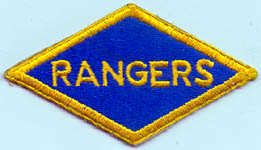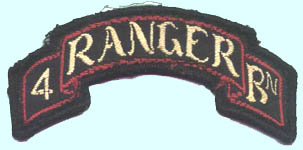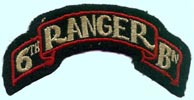
The 1st Special Service Force was a joint U.S.-Canadian unit trained for winter operations behind enemy lines. The unit wore crossed arrows rather than standard infantry branch insignia and had its own shoulder sleeve insignia approved in 1942 (original example above). Geoffrey Pyke, a brilliant if eccentric Englishman, originally conceived of a special force able to dominate the winter battlefield. The unit consisted of three small regiments and a service battalion. However, the original mission for which the unit was created was canceled and the unit saw hard service in Italy and Southern France before it was inactivated in December 1944/January 1945.
The ranger force of the U.S. Army was created in the summer of 1942 to conduct raids behind enemy lines or on enemy coastlines and was modeled on British Commandos. Major William O. Darby was given command of the new unit training in the United Kingdom, which expanded to three battalions (First, Third and Fourth) and were collectively called "Darby's Ranger's." An additional two battalions (Second and Fifth) were trained at Camp Forrest, Tennessee and sent to Europe prior to D-Day. The Sixth Ranger Battalion was created in 1944 from the 98th Field Artillery and was active in the Pacific theater.

The basic ranger shoulder sleeve insignia was approved in 1943 for all ranger units.

| 
|
| 4thRanger Battalion Italian-made Variation without the "th" | 6thRanger Battalion Usual Type |
Unapproved shoulder sleeve insignia exist for the six Ranger Infantry Battalions raised during World War Two. All are similar appearance with the appropriate battalion number. The design for the insignia was conceived by First Sergeant Anthony Rada of the 1st Ranger Battalion in 1942, while the unit was stationed in Northern Ireland. Although this design predates the approved insignia that was adopted in 1943, many units continued to wear Rada's design. Ranger units suffered heavy casualties during a number of hard fought battles of the war, including the Dieppe raid, Cisterna on the Anzio beachhead and Pointe du Hoc during the Normandy landing. These patches have been extensively reproduced and faked during the postwar period.